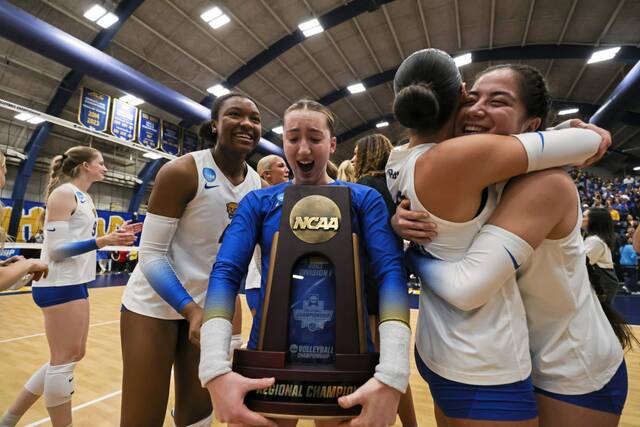Wanna get Pitt volleyball fever? Here are 5 things to know about the fast-paced college sport
Women’s volleyball has become one of the most entertaining sports across the college sports universe.
ESPN will televise Thursday’s NCAA Division I semifinals in Tampa, Fla., as Pitt takes on Nebraska at 7 p.m., followed by Texas vs. Wisconsin.
The championship match will is set for 3 p.m. Sunday on ABC.
Viewers have certainly tuned in during the postseason. ESPN reported more than 1 million viewers for three regional matches, including 379,000 for Oregon vs. Wisconsin.
Different venue, same Pitt ???? pic.twitter.com/tdaF3C6ol7
— Pitt Volleyball (@Pitt_VB) December 13, 2023
Here are 5 things to know about women’s college volleyball ahead of the NCAA semifinals:
What’s with the rotation?
Each team plays with six players on the court — setter, middle blocker(s), outside hitter(s), opposite, libero/defensive specialist — and they rotate after a point that results in a change of serve, also known as a side out.
Players move clockwise one spot so all players rotate through the serving position.
Coaching strategy comes into play with what players are subbed in to certain places within the rotation to highlight their specialty, whether it may be serving, blocking, hitting, passing or digging.
The dig ????
The kill ????Olivia Babcock.
???? ESPNU pic.twitter.com/kU17hyrHmT
— Pitt Volleyball (@Pitt_VB) December 9, 2023
What does each player do?
Setter: Runs the team’s offense and feeds sets to the hitters. A setter needs to be a good communicator and passer who can identify weak spots in the opposing defense.
Outside hitter: A hitter that attacks from the left side and the primary offensive attacker. This player is usually relied on to receive serves and have back-row skills in addition to being the top hitter.
Middle blocker: Typically the team’s tallest players, they block the center of the net against middle attacks and slide to each side to pair with the outside and opposite hitters on blocks. They also are capable hitters offensively on quick sets.
Opposite: A hitter from the right-side, they are usually able to hit from the front or back row. They work with the middle blocker and also handle some setting when needed.
Defensive specialist: Plays in the back row, responsible for receiving serve, defensive plays and passing to the setter.
Libero: Back-row player similar to defensive specialist. See below.
Our girl Emma crushes it on the quick ????
Pitt - 17
Louisville - 20 pic.twitter.com/pSw3OwCFzW— Pitt Volleyball (@Pitt_VB) December 9, 2023
Why does she have a different jersey?
Casual viewers of volleyball always have the same first question: Why does that player have on a different colored jersey than her teammates?
That would be the libero, who wears a white jersey when her teammates wear their colored jerseys or vice versa.
It is to differentiate who the libero is in the lineup.
A libero is a back-row player and defensive specialist who is normally one of the team’s best passers and is restricted by rules limiting hitting, blocking and setting.
The libero cannot complete an attack hit when the ball is above the net and cannot perform an overhead set in front of the attack line (10-foot line). They are essentially, at times, limited to where they can play balls on the court.
The libero also can only be replaced in the rotation by the same player she has replaced.
The most basic reason coaches use a libero is that their substitutions are not counted toward a coach’s 15 substitution maximum.
Coaches commonly sub in a libero for a middle blocker when the middle blocker rotates to the back row.
We hit the media timeout here in the Field House.
What a battle this is ????
Pitt - 14
Louisville - 15 pic.twitter.com/UAofc3YhRz— Pitt Volleyball (@Pitt_VB) December 9, 2023
Lots of encouragement
Being in a gym during a college volleyball match can overwhelming to your hearing.
Cheering is as much a part of the game as hitting, blocking and setting.
The players get together after each point for a quick huddle and cheer or chant.
Those celebrations can help maintain momentum or keep the crowd energized during matches, which can stretch as far as five sets.
And the crowds are known to be rather rowdy as well, especially during key conference matches or in the tournament.
THE PITT WALL ???? #NCAAWVB x ???? ESPNU / @Pitt_VB pic.twitter.com/ss2rR7HLMU
— NCAA Women's Volleyball (@NCAAVolleyball) December 9, 2023
Who are the NCAA’s best?
Stanford has advanced to the championship match 17 times and won nine, the most in NCAA history since the tournament began in 1981.
Penn State is close behind with seven titles, including four straight from 2007-10.
Among the Final Four participants, defending champion Texas is looking for its fourth title and is in the semifinals for the 15th time; Wisconsin is making its sixth trip to the semis and looking for a second championship; Nebraska is seeking a sixth championship and playing in the semifinals for a 17th time; and Pitt reached the semifinals for a third straight year in search of its first title.
The only team to play in the last three national semifinals?
Pitt Volleyball. pic.twitter.com/pU4NzgWARK
— Pitt Volleyball (@Pitt_VB) December 10, 2023
Here’s a look at teams that have won NCAA Division I women’s volleyball championships:
Stanford, 9
Penn State, 7
Nebraska, 5
UCLA, 4
Hawaii, 3
Long Beach State, 3
Texas, 3
USC, 3
Pacific, 2
Kentucky, 1
Washington, 1
Wisconsin, 1
Remove the ads from your TribLIVE reading experience but still support the journalists who create the content with TribLIVE Ad-Free.

